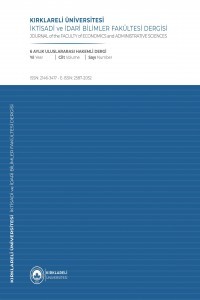İSLAMİ ENDEKSLERİN ÇEŞİTLENDİRME POTANSİYELİ: KOENTEGRASYON YAKLAŞIMI
Amaç: Bu çalışmanın temel amacı İslami endekslerin konvansiyonel yatırımcılar açısından ulusal çeşitlendirme fırsatı sunup sunmadığının ve riskten korunma amacıyla kullanılıp kullanılamayacağının ortaya konmasıdır. Veri seti Türkiye, Malezya, Amerika Birleşik Devletleri ve İngiltere örneğinde Dow Jones ve Morgan Stanley Capital International tarafından hesaplanan İslami ve konvansiyonel endekslerden oluşmaktadır. Yöntem: Ampirik uygulamada durağanlık sınaması için klasik birim kök testlerinden Genişletilmiş Dickey-Fuller ve Philips-Perrron testi benimsenmiştir. İslami endeksler ile konvansiyonel muadilleri arasında koentegrasyon ilişkisi olup olmadığı ise Engle-Granger ve Johansen koentegrasyon testleri kullanılarak ortaya konmuştur. Bulgular: Elde edilen ampirik bulgulara göre Dow Jones Türkiye İslami endeksi istisna olmak üzere Türkiye, Malezya, Amerika Birleşik Devletleri ve İngiltere örneğinde ele alınan İslami endeksler ile konvansiyonel muadilleri arasında koentegrasyon ilişkisinin varlığından bahsetmek mümkün değildir. Bu bulgular, İslami endekslerin konvansiyonel yatırımcılar açısından belirli ölçüde ulusal çeşitlendirme fırsatı sunduğunu ve riskten korunma amacıyla kullanılabileceğine işaret etmektedir.
Anahtar Kelimeler:
İslami Finans, İslami Endeksler, Koentegrasyon Analizi
___
- Abbes, M. B., & Trichilli, Y. (2015). Islamic stock markets and potential diversification benefits. Borsa Istanbul Review, 15(2), 93–105.
- Alam, N., & Rajjaque, M. S. (2010). Shariah-compliant equities: Empirical evaluation of performance in the European market during credit crunch. Journal of Financial Services Marketing, 15(3), 228–240.
- Albaity, M., & Ahmad, R. (2008). Performance of syariah and composite indices: Evidence from Bursa Malaysia. Asian Academy of Management Journal of Accounting & Finance, 4(1), 23–43.
- Alexander, C. (2001). Market models: A guide to financial data analysis. Chichester, UK, New York, NY: Wiley.
- Bahmani-Oskooee, M., & Brooks, T. J. (2003). A new criteria for selecting the optimum lags in Johansen's cointegration technique. Applied Economics, 35(8), 875–880.
- Bakri, A. K., Akila Mohd. Kassim, N., & Affendy Arip, M. (2010). The subprime crisis and Islamic stock markets integration. International Journal of Islamic and Middle Eastern Finance and Management, 3(4), 363–371.
- Balcilar, M., Jooste, C., Hammoudeh, S., Gupta, R., & Babalos, V. (2015). Are there long-run diversification gains from the Dow Jones Islamic finance index? Applied Economics Letters, 22(12), 945–950.
- Brooks, C. (2008). Introductory econometrics for finance (2nd ed.). Cambridge [England], New York: Cambridge University Press.
- Charfeddine, L., Najah, A., & Teulon, F. (2016). Socially responsible investing and Islamic funds: New perspectives for portfolio allocation. Research in International Business and Finance, 36, 351–361.
- Dickey, D.A., & Fuller, W.A. (1979), Distribution of the estimators for autoregressive time series with a unit root. Journal of the American Statistical Association, 74, 427–431.
- Dickey, D.A., & Fuller, W.A. (1981), Distribution of the estimators for autoregressive time series with a unit root. Econometrica, 49, 1057-1072.
- Engle, R., & Granger, C. (1987). Co-integration and error correction: Representation, estimation, and testing. Econometrica, 55(2), 251-276.
- Ertek, T. A. (1996). Ekonometriye giriş (Genişletilmiş 2.baskı). İstanbul: Beta Basım Yayım.
- Girard, E., & Hassan, M. K. (2008). Is there a cost to faith-based investing: Evidence from FTSE Islamic indices. The Journal of Investing, 17(4), 112–121.
- Göktaş, Ö. (2005). Teorik ve uygulamalı zaman serileri analizi. İstanbul: Beşir Kitabevi.
- Gujarati, D. N., & Porter, D. C., (2014). Temel ekonometri (2. basım). İstanbul: Literatür Yayıncılık.
- Guyot, A. (2011). Efficiency and dynamics of Islamic investment: Evidence of geopolitical effects on Dow Jones Islamic Market indexes. Emerging Markets Finance and Trade, 47(6), 24–45.
- Hassan, M. K., & Girard, E. (2010). Faith-based ethical investing: The case of Dow Jones Islamic indexes. Islamic Economic Studies, 17(2), 1–31.
- Hoque, H., Kabir, S. H., Abdelbari, E. K., & Manahov, V. (2016). Islamic and conventional equity market movements during and after the financial crisis: Evidence from the newly launched MSCI indices. Financial Markets, Institutions & Instruments, 25(4), 217–252.
- Johansen S. (1988). Statistical analysis of cointegrating vectors. Journal of Economic Dynamics and Control, 12, 231-254.
- Johansen, S., & Juselius, K. (1990). Maximum likelihood estimation and inference on cointegration-with applications to the demand for money. Oxford Bulletin of Economics and Statistics, 52(2), 169–210.
- Johansen, S. (1995). A statistical analysis of cointegration for I(2) variables. Econometric Theory, 11(1), 25-59.
- Kennedy, P., Sarımeşeli, M., & Açıkgöz, Ş. (2006). Ekonometri kılavuzu. Ankara: Gazi Kitabevi.
- Khamlichi, A. E., Sarkar, K., Arouri, M., & Teulon, F. (2014). Are Islamic equity indices more efficient than their conventional counterparts?: Evidence from major global index families. The Journal of Applied Business Research, 30(4), 1137–1150.
- Kok, S., Giorgioni, G., & Laws, J. (2009). Performance of Shariah-compliant indices in London and NY stock markets and their potential for diversification. International Journal of Monetary Economics and Finance, 2(3/4), 398-408.
- Kwiatkowski, D., Phillips, Peter C. B., Schmidt, P. & Shin, Y. (1992). Testing the null hypothesis of stationarity against the alternative of a unit root : How sure are we that economic time series have a unit root? Journal of Econometrics, 54(1-3), 159-178.
- MacKinnon, C. (1991). Reflections on sex equality under law. The Yale Law Journal, 100(5), 1281-1328.
- Masih, M., Mohammed A., & Al-Sahlawi and Lurion De Mello. (2008). What drives carbon-dioxide emissions: Income or electricity generation? Evidence from Saudi Arabia. The Journal of Energy and Development, 33(2), 201–213.
- Perron, P. (1989). The great crash, the oil price shock, and the unit root hypothesis. Econometrica, 57(6), 1361-1401.
- Phillips, P.C.B., & Perron, P. (1988). Testing for unit roots in time series regression. Biometrika, 75, 335-346.
- Sevüktekin, M., & Nargeleçekenler, M. (2005). Zaman serileri analizi (1.basım). Ankara: Nobel Yayınları.
- Sargan, J. (1964). Three-stage least-squares and full maximum likelihood estimates. Econometrica, 32(1/2), 77-81.
- Stock, J. H., Watson, M. W., & Saraçoğlu, B. (2011). Ekonometriye giriş (1.basım). Ankara: Efil.
- Tarı, R. (2011). Ekonometri (7.basım). Kocaeli: Umuttepe Yayınları.
- ISSN: 2146-3417
- Yayın Aralığı: Yılda 2 Sayı
- Başlangıç: 2012
- Yayıncı: Kırklareli Üniversitesi
